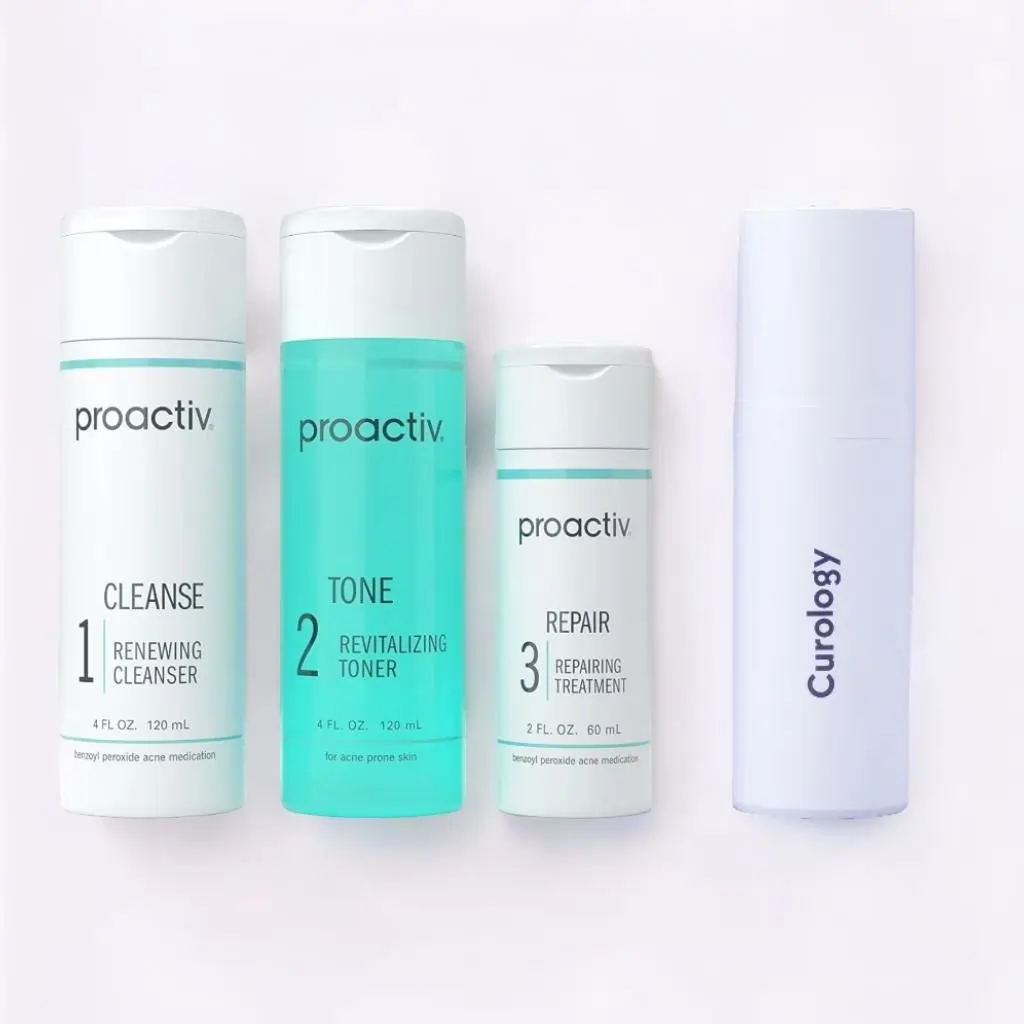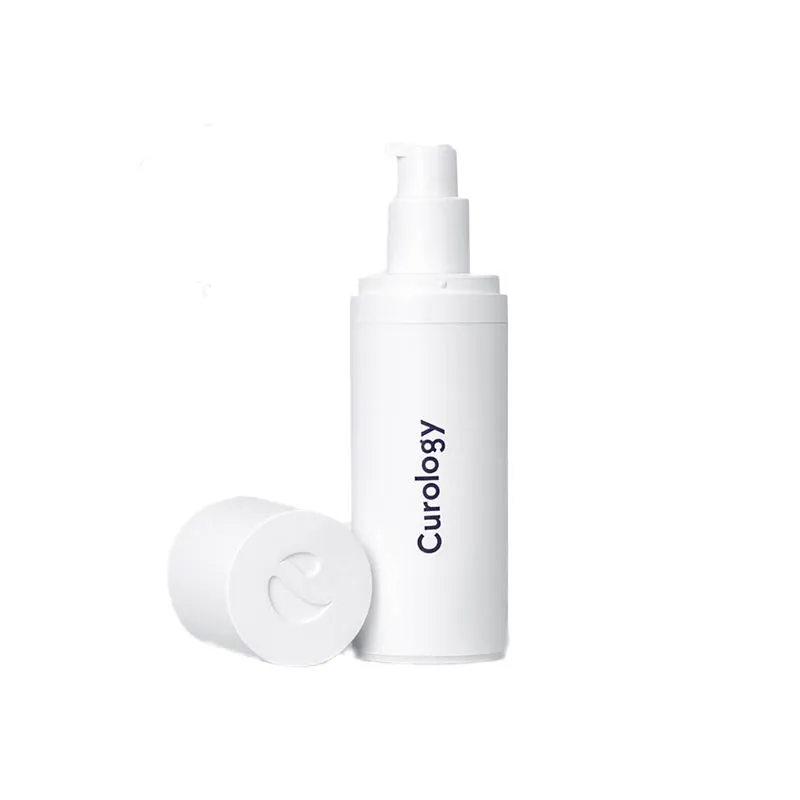
Proactiv vs Curology 2024 (The Definitive Guide)
Whether you’re a seasoned skincare aficionado or just starting out, Proactiv and Curology are two brands that have probably crossed your radar at least once. You might even have a few of their products on your shelf right now.
Today, we will be comparing Proactiv vs Curology and their best-selling acne treatments side-by-side to help you figure out which brand better suits you and your skin. Enjoy!
This post contains affiliate links; as an Amazon Associate we earn commission from qualifying purchases.
Proactiv Solution vs Curology Custom Formula for Acne
Two options that have rightfully earned their spot at the top when it comes to dealing with acne, Proactiv and Curology, have made treating acne more accessible and affordable to millions on a global scale.
Proactiv’s 3-Piece System and Curology’s Custom Formula for Acne (plus their cleanser and moisturizer set) have caught the attention of celebrities and regular people alike, delivering miraculous results.
Though these two sets are among the best out there, they achieve such results quite differently. Let’s take a closer look.
As you may already know, Proactiv’s been on the skincare scene for quite some time—almost 30 years to be exact. Curology is slightly on the newer side in comparison, founded in 2014. However, the major difference between the two is that Curology was the first service to offer customized prescription skincare (without having to visit a doctor).
Proactiv has three different combinations of their 30-day three-piece systems for dermal conditions such as post-acne dark marks, redness from acne, stubborn acne with combo or oily skin, and whiteheads/blackheads with sensitive or dry skin. Each kit—Proactiv, Proactiv+, and ProactivMD—comes with a cleanser and two formulas that actively work to address your skin woes. The classic trio, Proactiv, leans on benzoyl peroxide and glycolic acid to fight its acne battles, while Proactiv+ uses a micronized version of the benzoyl peroxide treatment, and ProactivMD’s adapalene gel does most of its trio’s heavy lifting.
Chances are, you’ve probably used benzoyl peroxide at some point if you’ve struggled with acne—it’s one of the familiar faces you’ll see on face wash and spot treatment bottles at the pharmacy. This oldie (but goodie) substance attacks the bacteria on your skin and in turn unclogs pores. Adapalene gel, however, was only legalized (in the US) in 2016 to be used over the counter. That said, this retinoid is stronger than benzoyl peroxide and may be a bit intense for some users. Further, it works on a deeper, cellular level to fight the most stubborn of breakouts.
On the other hand, Curology requires that you first take a quiz to name your specific skin needs, then a dermatology provider prescribes you a medicated formula. Some of their standout ingredients include tretinoin, clindamycin, and metronidazole. Tretinoin is a retinoid (like Proactiv’s adapalene gel) that treats acne by reducing the production of skin’s natural oils and improves the appearance of dark spots and fine lines (hello, anti-aging perk!). Both clindamycin and metronidazole are antibiotics that combat bacteria and calm inflammation. Thus, you may find that your treatment ends up being a combination of these ingredients. (For example, my Curology formula includes tretinoin, clindamycin, and azelaic acid.)
Unlike Proactiv’s skincare systems, Curology’s star player is the customized formula, which can be purchased on its own and then used in tandem with other, non-Curology products. However, Curology does recommend purchasing the customized formula with their cleanser and moisturizer duo. Their cleanser is a one-size-fits-all face wash, but you can choose between their “large rich moisturizer” for dry or aging skin, and the “large moisturizer” for normal to oily skin.
In terms of overall effectiveness, the classic Proactiv system has 4.1 (out of 5) stars; Proactiv+ has 3.6 stars; and ProactivMD has 3.5 stars. Curology claims to have over 9,000 5-star reviews with 93% of customers reporting that their prescribed potion was effective. (And they have some impressive before-and-after photos on their “Reviews” page, to boot.)
Now, let’s talk cost. According to their site, all three of Proactiv’s 30-day kits will run you ~$30 each as a one-time purchase. Curology reveals a bit less about their prices, with their homepage ultimately luring you in to take their skin concern quiz. (To be fair, though, they’re up-front about offering a free 30-day trial.) But as a Curology customer myself, I can confirm that my monthly formula is $20 on its own and adding the cleanser and moisturizer set is an extra $10. (Disclaimer: I can’t confirm if a different formula may cost more or less than mine.)
Final Verdict
Treating acne and acne-adjacent skin conditions can be complicated to navigate, especially if you don’t know where to start. But accessible resources with various options, like Proactiv and Curology, may be the answer.
Having used both myself, I can say that Curology worked better for my hormonal/adult acne needs than Proactiv. However, I did use Proactiv for a time in high school when hormonal acne wasn’t yet an issue, and it kept my pesky teenage whiteheads at bay.
Conclusively, though, 10 times out of 10 I would personally choose Curology for any of my skin troubles. Why? Well, I had a medical professional create a formula specific to my acne and anti-aging needs. Therefore, using Curology already felt less risky than purchasing and testing out an entire system that might work.
Further, it’s still unclear whether Proactiv is cruelty-free or vegan, but we can at least confirm that they’re not certified as either by any organizations. Proactiv doesn’t appear to have any commitment to sustainability, either. Just a few years ago, Curology received its cruelty-free certification from the Leaping Bunny program. They also require that their ingredients and laboratories are vegan-friendly. These qualities are great, but Curology, too, doesn’t seem to have any stance or action(s) towards being more sustainable.
While the decision between these two appears easy, we’d still like to encourage browsing Proactiv’s array of products outside of their skincare systems, too. Who knows—maybe your best skin yet will come from using both brands.
This article was originally published on September 9th 2022, but it has been reviewed and updated with the latest available information on February 13th 2024 by Sara Mckay, MA.
Related articles
Proactiv vs Proactiv MD (The Definitive Guide)
Proactiv vs Proactiv Plus (The Definitive Guide)
Proactiv Plus vs Proactiv MD (The Definitive Guide)
Proactiv vs Murad 2023 (The Definitive Guide)
MDacne vs Curology (The Definitive Guide)
Read more
Obagi Blender vs Clear (The Definitive Guide)
Aveda vs Moroccan Oil 2023 (The Definitive Guide)
Calum Torrington is the founder of FemmeNordic. He has worked as a beauty editor since 2020 and employs his analytical background in mathematics to thoroughly scrutinize complex INCI lists. Now, he helps over 1 million people per year to find the best beauty products.

